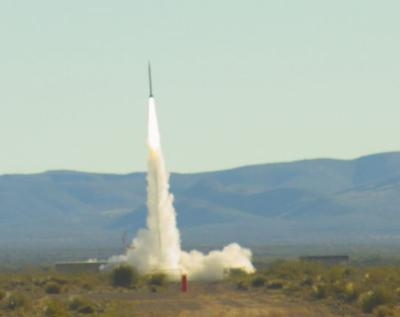Sat, Nov 14, 2015
An UP Aerospace SpaceLoft Rocket Demonstrated The Capability To Eject Separate Payloads Requiring Independent Re-Entry
An UP Aerospace SpaceLoft rocket carrying several scientific and engineering experiments was successfully launched late last week from Spaceport America in New Mexico. The launch took place Friday morning at 8:01 MST from Spaceport America's Vertical Launch Complex-1 on the East Campus. This launch represents Spaceport America's 24th overall launch and the fourth from Spaceport America with NASA Flight Opportunities Program payloads.

The SpaceLoft commercial research rocket was launched within the dedicated 2 1/2-hour launch window, and flight data indicate the rocket attained a maximum altitude of approximately 74.98 miles. The parachute recovery system brought the rocket and its payloads safely back. The payloads were recovered intact 30.83 miles downrange on the U.S. Army White Sands Missile Range as planned.
This is the first mission in which UP Aerospace demonstrated the capability to eject separate payloads that require independent re-entry into the atmosphere. Three separate parachutes provided soft landing of payload components.
"Spaceport America congratulates UP Aerospace on a successful launch and for being the first private commercial-space company to demonstrate independent payload re-entry," said Spaceport America CEO Christine Anderson. "Spaceport America is also proud to support these important research payloads for NASA and academia."
"I would like to thank Spaceport America for hosting all ten of the SpaceLoft missions," explained UP Aerospace President Jerry Larson. "We look forward to offering our new independent re-entry capabilities which we have demonstrated with this mission to other customers in the future."
The payload flown on the UP Aerospace SL-10 rocket included the following:
- Maraia Earth Return Capsule from NASA Johnson Space Center. This experiment tested a reentry capsule being developed to return small satellites and individual payloads from orbit on-demand.
- AVA from NASA Ames Research Center. This was a test of a developmental, low-cost avionics package, which will ultimately be used to monitor and control launcher systems designed for small satellites.
- Green Propellant experiment from Purdue University. This experiment studied surface tension behavior of a new "green" rocket propellant in low gravity. Results will be used to validate propellant management devices applicable to both geostationary and interplanetary spacecraft.
- SOF-2 from New Mexico State University. This experiment tested an autonomous, robotic method to identify unknown or changed inertia properties (mass, center of mass, moments of inertia) of a spacecraft. This will be used to enhance control capability of future on-orbit servicing missions such as satellite refueling, rescue, repair, and orbit debris removal.
(Image provided with Spaceport America news release)
More News
19-Year-Old Pilot Was Attempting to Fly Solo to All Seven Continents On his journey to become the first pilot to land solo on all seven continents, 19-year-old Ethan Guo has hit a >[...]
From 2017 (YouTube Edition): A Quality LSA For Well Under $100k… Aeroprakt unveiled its new LSA at the Deland Sport Aviation Showcase in November. Dennis Long, U.S. Importer>[...]
Hazardous Weather Information Summary of significant meteorological information (SIGMET/WS), convective significant meteorological information (convective SIGMET/WST), urgent pilot>[...]
Aero Linx: Historic Aircraft Association (HAA) The Historic Aircraft Association (HAA) was founded in 1979 with the aim of furthering the safe flying of historic aircraft in the UK>[...]
"We would like to remember Liam not just for the way he left this world, but for how he lived in it... Liam was fearless, not necessarily because he wasn't afraid but because he re>[...]
 TikToker Arrested After Landing His C182 in Antarctica
TikToker Arrested After Landing His C182 in Antarctica Classic Aero-TV: Versatile AND Practical - The All-Seeing Aeroprakt A-22 LSA
Classic Aero-TV: Versatile AND Practical - The All-Seeing Aeroprakt A-22 LSA ANN's Daily Aero-Term (06.27.25): Hazardous Weather Information
ANN's Daily Aero-Term (06.27.25): Hazardous Weather Information ANN's Daily Aero-Linx (06.27.25)
ANN's Daily Aero-Linx (06.27.25) Aero-News: Quote of the Day (06.27.25)
Aero-News: Quote of the Day (06.27.25)



